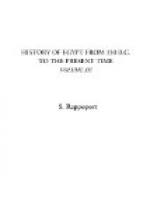The American subscriptions from the year 1883 rapidly increased, and by the year 1895 had figured up to $75,800, and the total number of letters and articles written during that time had grown to 2,467. The organisation in America consists of a central office at Boston, together with independent local societies, such as have already been formed in New York, Philadelphia, and Chicago. The Boston office, and any independent local society, which subscribes not less than $750 a year, is entitled to nominate a member of the Committee. At the end of July, 1884, Doctor Winslow had forwarded to London $1,332.20.
The Fund has always preserved amicable relations with the Government Department of Antiquities in Egypt. Excavations are conducted by skilled explorers, and the results published promptly with due regard to scientific accuracy and pictorial embellishment. The antiquities found are either deposited in the National Museum at Cairo, or distributed among public museums in the United Kingdom and the United States of America and Canada, in strict proportion to the contribution of each locality. Exhibitions are usually held in London in July of each year.
The Fund now consists of three departments, for each of which separate accounts are kept. These departments are: 1. The Exploration Fund, for conducting archeological research generally, by means of systematic excavations. 2. The Archaeological Survey, for preserving an accurate pictorial record of monuments already excavated but liable to destruction. 3. The Graeco-Roman Branch, for the discovery of the remains of classical antiquity and early Christianity.
The first work of the Graeco-Roman Branch was to publish the recently discovered Oxyrrhynchos papyri, of which two volumes, containing many important classical and theological texts, were issued in 1898 and 1899 and 1900. Among its contents are parts of two odes of Pindar, of which one begins with a description of the poet’s relation to Xenocritus, the inventor of the Locrian mode of music; a considerable piece of the “Kolax” of Menander, one of the two plays upon which the “Eunuchus” of Terence was based; part of a rhetorical treatise in Doric dialect, which is undoubtedly a work of the Pythagorean school; the conclusion of the eighteenth Keo-Tcfe of Julius Africanus, dealing with a question of Homeric criticism; and part of a biography of Alcibiades. A new light is thrown upon some of the less-known departments of Greek literature by a well-preserved papyrus, which contains on one side a prose mime in two scenes, a work of the school of Sophron, having points of resemblance to the fifth mime of Herondas; while on the other side is an amusing farce, partly in prose, partly in verse. The scene is laid on the shores of the Indian Ocean, and the plot turns upon the rescue of a Greek maiden from the hands of barbarians, who speak a non-Greek language with elements apparently derived from Prakrit.*




